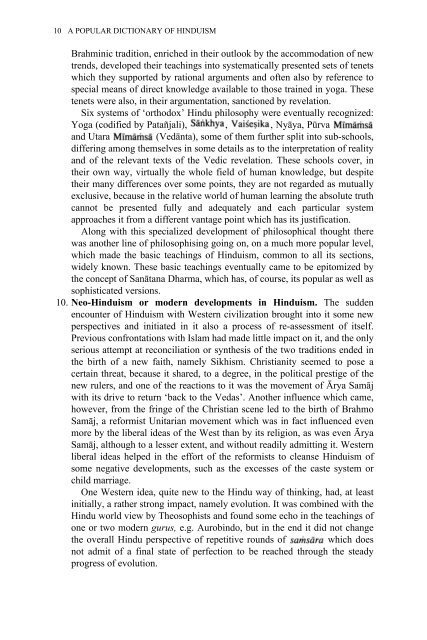You also want an ePaper? Increase the reach of your titles
YUMPU automatically turns print PDFs into web optimized ePapers that Google loves.
10 A POPULAR DICTIONARY OF HINDUISM<br />
Brahminic tradition, enriched in their outlook by the accommodation <strong>of</strong> new<br />
trends, developed their teachings into systematically presented sets <strong>of</strong> tenets<br />
which they supported by rational arguments and <strong>of</strong>ten also by reference to<br />
special means <strong>of</strong> direct knowledge available to those trained in yoga. These<br />
tenets were also, in their argumentation, sanctioned by revelation.<br />
Six systems <strong>of</strong> ‘orthodox’ Hindu philosophy were eventually recognized:<br />
Yoga (codified by Patañjali), , , Nyāya, Pūrva<br />
and Utara (Vedānta), some <strong>of</strong> them further split into sub-schools,<br />
differing among themselves in some details as to the interpretation <strong>of</strong> reality<br />
and <strong>of</strong> the relevant texts <strong>of</strong> the Vedic revelation. These schools cover, in<br />
their own way, virtually the whole field <strong>of</strong> human knowledge, but despite<br />
their many differences over some points, they are not regarded as mutually<br />
exclusive, because in the relative world <strong>of</strong> human learning the absolute truth<br />
cannot be presented fully and adequately and each particular system<br />
approaches it from a different vantage point which has its justification.<br />
Along with this specialized development <strong>of</strong> philosophical thought there<br />
was another line <strong>of</strong> philosophising going on, on a much more popular level,<br />
which made the basic teachings <strong>of</strong> <strong>Hinduism</strong>, common to all its sections,<br />
widely known. These basic teachings eventually came to be epitomized by<br />
the concept <strong>of</strong> Sanātana Dharma, which has, <strong>of</strong> course, its popular as well as<br />
sophisticated versions.<br />
10. Neo-<strong>Hinduism</strong> or modern developments in <strong>Hinduism</strong>. The sudden<br />
encounter <strong>of</strong> <strong>Hinduism</strong> with Western civilization brought into it some new<br />
perspectives and initiated in it also a process <strong>of</strong> re-assessment <strong>of</strong> itself.<br />
Previous confrontations with Islam had made little impact on it, and the only<br />
serious attempt at reconciliation or synthesis <strong>of</strong> the two traditions ended in<br />
the birth <strong>of</strong> a new faith, namely Sikhism. Christianity seemed to pose a<br />
certain threat, because it shared, to a degree, in the political prestige <strong>of</strong> the<br />
new rulers, and one <strong>of</strong> the reactions to it was the movement <strong>of</strong> Ārya Samāj<br />
with its drive to return ‘back to the Vedas’. Another influence which came,<br />
however, from the fringe <strong>of</strong> the Christian scene led to the birth <strong>of</strong> Brahmo<br />
Samāj, a reformist Unitarian movement which was in fact influenced even<br />
more by the liberal ideas <strong>of</strong> the West than by its religion, as was even Ārya<br />
Samāj, although to a lesser extent, and without readily admitting it. Western<br />
liberal ideas helped in the effort <strong>of</strong> the reformists to cleanse <strong>Hinduism</strong> <strong>of</strong><br />
some negative developments, such as the excesses <strong>of</strong> the caste system or<br />
child marriage.<br />
One Western idea, quite new to the Hindu way <strong>of</strong> thinking, had, at least<br />
initially, a rather strong impact, namely evolution. It was combined with the<br />
Hindu world view by Theosophists and found some echo in the teachings <strong>of</strong><br />
one or two modern gurus, e.g. Aurobindo, but in the end it did not change<br />
the overall Hindu perspective <strong>of</strong> repetitive rounds <strong>of</strong> which does<br />
not admit <strong>of</strong> a final state <strong>of</strong> perfection to be reached through the steady<br />
progress <strong>of</strong> evolution.


















